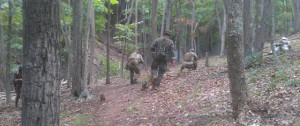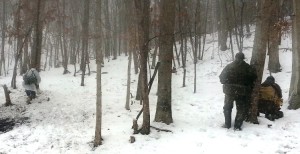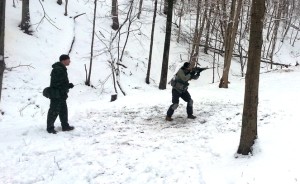Clarification on Training
There has been some recent chit chat about training: methods and purpose and all that. In various locations and in the comments on the Enemies Foreign and Domestic vs. Patriot Dawn post. Some would have you think it is a complicated matter. My intent today is to make it simple; it is a subject that mainly is just misunderstood, or lost in the BS.
Those of you that read this blog are doing so because you are concerned to improve your tactical readiness for any kind of SHTF situation, where you may be required to repel boarders, up to and including using firearms and lethal force. To be adequately prepared for this, you must master the basics of weapon training all the way up to team level small unit tactics. Regarding my discussion of the tyranny continuum, pre- and post-collapse and all that, it doesn’t really matter where you are sat on the sliding scale of boiling frog when IT goes down. It doesn’t matter if you are wearing camo or jeans and a t-shirt. That is just window dressing, style if you like. If you have to fight, you have to fight, and the basics of weapons proficiently at an individual level, and small unit tactics at a team level, come into play.
Some would have you think that this is complicated and that there are different schools of thought on training out there, and that you must choose one. For example this is sometimes termed as ‘Appleseeders’ vs. ‘Tacticoolers’ vs. ‘SUT guys’. All this is just a perversion of the training progression.
Let me explain: when training a soldier, which is what we are training when we train an individual to become proficient at team level SUT, we follow a training progression. In summary, we can describe it like this, on the purely weapons training side (there are other strands, such as fieldcraft, that come together to create the finished product):
1. Marksmanship Fundamentals: i.e the basics of shooting
2. Grouping and Zeroing: training to create smaller shot groups and greater accuracy/consistency. Success at this level will permeate the more advanced levels as a solid foundation of competency.
3. Application of Fire: the relationship between point of aim and point of impact at varying ranges and condition, such as cross winds. Applying accurate fire to targets. Simple example: seeing your rounds strike low, you can either aim up, or change your sight settings for the longer range, in order to bring the rounds onto the target. Progression to various firing positions.
4. Transition to Field Firing: The addition of basic movement, and more complex target arrays (incl. movers) at an individual and buddy pair level. Basic fire and movement, still on a flat square type range, using contrived cover (barriers and such). Increased dynamic weapon manipulation, mag changes etc.
5. Field Firing: full tactical movement and employment of the team and weapons systems to solve a tactical problem, such as a squad assault, break contact drills etc.
On my CRCD class, I expect that you will arrive with a basic level of competency at the first three levels. This means you have a zeroed battle rifle that you can competently manipulate. You can apply accurate fire to targets from static positions. With the training scheme that I have developed for CRCD, I will take you through step 4 and on to step 5. It always helps, but you are not required to have completed any tactical movement with your rifle prior to CRCD – I have taken exclusively bench shooters through the class successfully. The Combat Patrol class is set at level 5, and concentrates on patrolling and live firing SUT.
The confusion comes in with the conflation of these training/progression levels with a specific end result due to agenda. This is for various reasons. Let me hazard a guess at what these may be:
1. The objective of the student. If the student sees no need for SUT, they will have no wish to progress to it.
2. Lack of facility. You cannot train live firing (Stage 5) SUT without a suitable facility. That is why I created one in West Virginia.
3. Lack of industry/trainer motivation.
So, ‘Appleseeders’ and long range shooter types are going as far as level 3. It’s a sport, and they are developing themselves as long range shooters. This does not make them snipers, and it does not include any ability to conduct SUT. The skill these marksman develop is excellent, at the sport of long range shooting. They are however branching out and specializing at level 3. This is where a lot of the problems concerning the ‘retreat sniper’ come in, the lone marksman on the hill, when it comes to applying these skills to an SHTF situation.
(Let me say that calling it ‘level 3’ implies no actual criticism of the sport they are engaged in, or the shooting skill they will develop).
The ‘tacticoolers’ are going as far as level 4 – so long as they master the previous levels and the shooting fundamentals and don’t just get on the berm range and blast away. If they just jump straight in at level 4, without the basics, then its just BS. For the tacticoolers, this is either a sport or a fan-boy ego thing, or a mix. For those for whom it is a sport, they may branch out into things like 3-gun. It’s still a sport, with limited tactical application. Yes, if I was accosted in an alleyway in a lethal force shoot scenario, I would prefer to be a competent ‘3 gunner’ than not. Granted, these guys can apply fire, but it is still not full SUT. They rarely move beyond an individual level. The other problem is when you have trainers who either won’t or can’t take them beyond stage 4, and who have them doing all the silly things you see in the tacticool videos, such as walking around blue barrels, or spinning in slow circles, or simply misapplying CQB training drills to an outdoors environment – that is when the training leaves a useful progression continuum and just becomes a means to its own end.
An analogy I have seen used is that of fighting – such as MMA being ‘just a sport’ and not ‘street fighting’. This has limited utility, but we can use it to illustrate a parallel: Are we saying that your MMA fighter (read tacticooler, non-poseur type) is simply going to get wiped out? No, he can fight really well, even though he is training for a sport. He can beat 99% of people out there hand to hand, even though his fights are constrained by rules. He is well trained and can deliver serious damage. So, let me put this another way: put your MMA fighter (tacticooler) against a 4 man team (SUT trained) who are also MMA fighters (passed through the 5 stage training progression), but who moved beyond that to include tactics for use outside of (i.e. beyond) the individual ring sport . It’s a limited analogy/parallel, but I’m trying to push it to make a point. Not only will the advanced ‘SUT team’ apply tactics (surprise, terrain, accurate fire, sneaky, good drills), but they are working as a team.
So really we are seeing a problem of focus and objective. Whether it is because students don’t see the need for SUT, or they think that their brand of sharpshooting or berm shooting is sufficient to take care of any threats they may encounter, people are stopping at the various levels of training (or alternatively, they are entering at the wrong level and staying there: i.e. berm shooters). They end up specializing at their chosen level, in what is effectively just a sport, whether that be long range shooting or 3 gun, all of which have positive training attributes in their own right.
As an ‘SUT guy’ I do not disparage or demean the need for the good solid basics of the training progression. It is vital. I am simply critical of those who think that they are ‘tactically trained’ when they stop at level 3 or 4, and think “job done”. One thing that also needs to be considered is the vital holistic effect of team, which you will only really get into when you move onto SUT. Most of the stuff before that is individual or ‘easy pairs’ – just easy sequencing, without any real tactical decisions being required, or leadership/followership skills needing to be applied.
I see stuff written about how ‘berm shooting’ has merits, such as weapon manipulation and all that. Well, OF COURSE IT DOES. Going to the 100 meter point on a gallery range and zeroing your rifle, then putting in some good practice shooting groups out to 300 0r 400 meters has a ton of value. Practicing RTR on your berm range has a ton of value. But note: I said ‘practicing RTR‘, which means reactive shooting where you return fire, take cover and then return fire as appropriate. If all you have access to is said berm range, then make sure you ‘take a knee’ at minimum to simulate taking cover. Don’t be ‘that guy’ who feels he can dominate that firefight against paper targets from a standing position. Work within the range restrictions – if you can put up mock cover, then do so. But don’t base your whole tactical training around what you do on the flat range.
But, you have to know that what you are doing is right. My advice: take a training class with a reputable military instructor (one who teaches SUT to civilians). One of my classes, or Mason Dixon Tactical, Mountain Guerrilla etc. Then on your return continue maintenance training, applying what you have been taught, working with whatever range facility you have available. There is an element of ‘train the trainer’ involved in this. I mean, worst case, you can probably go on an indoor range, take the bench out, and move from standing to kneeling in the tight space. WORST CASE! It all has training value, however restricted. You might scare the staff and patrons though…;-)
The conclusion of this is to stress the need to not be waylaid by the hype, the BS. It is a training progression, with each of the levels suffering from distortion due to the agendas of a combination of the students and trainers involved. This leads to a branch out, creating specialisms at each level, from your long range shooters to your tacticoolers. If you want to get the best out of your tactical self defense training , you should follow a training route that takes you along the progression to SUT.
And let’s not be fooled. When we are training in the woods, we often wear camo, because it is appropriate to the environment. That in itself does not limit the utility of this SUT training to full-on post-SHTF situations in woods. A raid is a raid, whether you do it in the depths of the woods dressed in camo, or you get out of a van at an urban or semi-urban ORP and roll into it. What is consistent throughout is the skills and training, the TTP’s, that make a raid a success or an abortion. If you only ever train as far as berm shooting, or 3-gun, then you will have a bunch of individuals with no cohesive team training, probably minimum rehearsals because they don’t know what they don’t know, going ‘Hollywood’ on an objective. Best case, this simply becomes an attack by fire and they may enjoy a modicum of success. Worst case, they try ad tacticool their way through the objective and get shot to pieces.
Let’s cut the BS: whatever you want to wear to the party, it doesn’t matter. If you need to pull off a raid due to a clear and present threat pre-full-SHTF (whatever that is), you need to get squared away on the good solid SUT basics, train and rehearse as a team.
Live Hard.
Die Free.
Max
Admin point: if you have emailed me over the last week, and have not had a response, please email me again. It’s been Christmas, and I am currently down with a serious case of the ‘man-flu’. You all know how serious that gets, a minor case of a head cold, almost fatal for a guy, when there is nothing more to do than lay on the sofa and moan, hoping to generate enough sympathy that stuff will be brought to you. It’s not working for me right now…..;-)



